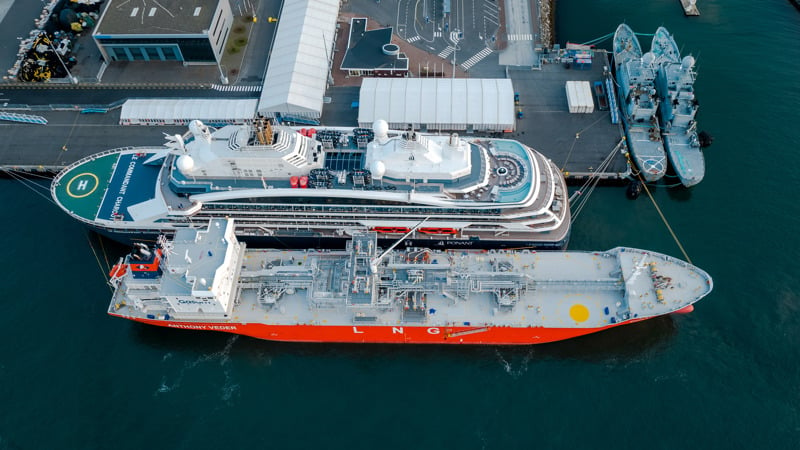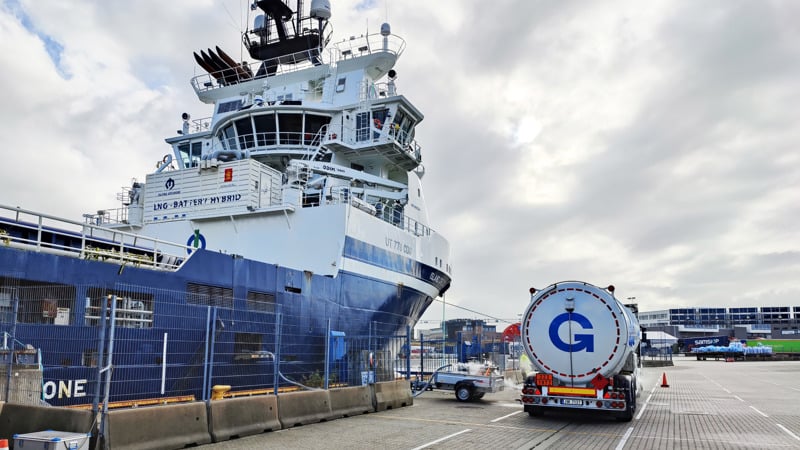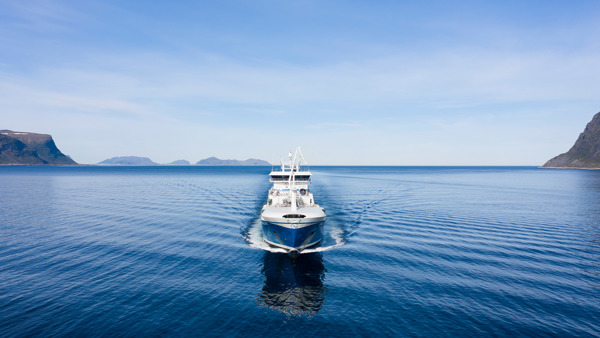LNG bunkering services for maritime transport
At Gasum, we are committed to supporting the maritime industry's transition to cleaner energy. As a leading provider of liquefied natural gas (LNG) and liquefied biogas (bio-LNG or LBG), we offer flexible, safe, and efficient bunkering solutions across Europe. Whether at sea or in port, our services are designed to meet the evolving needs of modern shipping.
What is LNG bunkering?
LNG bunkering is the process of refueling ships with liquefied natural gas or liquefied biogas (bio-LNG). LNG bunkering can be carried out in several ways, such as transferring fuel from one ship to another (ship-to-ship), from a truck to a ship (truck-to-ship), or directly from a terminal via pipeline (ex-pipe/ex-installation).
LNG is natural gas cooled to -162°C, which turns it into a liquid and reduces its volume by about 600 times. This makes it easier to store and transport, especially for maritime use. Liquefied biogas (bio-LNG or LBG) is made through the same cooling process as LNG. LNG and LBG are interchangeable with each other.
Our bunkering methods
Gasum offers several LNG bunkering options to suit different operational needs:
- Ship-to-ship bunkering
Conducted between two vessels either at sea or in port. Our LNG bunker vessels, Coralius and Kairos, have safely completed thousands of operations across Europe.
Coralius, with a capacity of approximately 5,800 cbm (around 2,450 MT), and Kairos, with 7,500 cbm (around 3,400 MT), are ready to serve both long-term and spot customers in Europe. Read more about our bunker vessels > - Truck-to-ship bunkering
Flexible and on-demand LNG delivery via tanker trucks at various European ports, subject to local regulations and permits. - Ex-pipe/Ex-installation delivery
LNG is delivered directly from a terminal or fixed installation to the vessel.
Contact us for more information:
Bunker desk
Maritime customers may inquire prices for LNG or LBG at:
bunkers@gasum.com
phone (Sweden): +46 73 511 59 73

Bunkering at sea and in ports
Bunkering LNG ship-to-ship can take place between two sea-going ships at anchorage or in port. Also, depending on the port restrictions, bunkering can be done efficiently at the same time as the vessel receiving LNG carries out simultaneous cargo operations.

In most ports, the LNG bunker vessel needs to have a license to operate, issued by local authorities. It is recommended to start the permit application well in advance of the ship-to-ship operation, as it normally involves several authorities.
Bunkering LNG ship-to-ship at sea does not usually require any special permit unless the operation takes place close to the shore. Typically, the bunkering operations take place in a position agreed with the Coast Guard within an anchorage area.

Truck-to-ship operations are conducted by Gasum at various European locations. These kinds of operations are flexible and can be made on-demand, subject to local authorities and permits. Hundreds of safe truck-to-ship operations are made by Gasum on an annual basis.
Gasum also offers Ex-pipe/Ex-installation deliveries at specific locations.
Safety first
To ensure a high safety standard, the crew on board both ships involved need to have the necessary training and instructions on how to handle the cryogenic LNG bunker equipment and procedures. After an initial compatibility check of the ships, a mooring study is done, and a checklist of all procedures is followed and ticked off by the respective crew. Utilizing digital tools such as FuelBoss, the operations can be optimized to save time.
When mooring and fendering arrangements are agreed upon, the LNG bunker vessel is positioned alongside the receiving ship and the final procedures are checked and ticked off. The hose is then connected, a leak test is performed, the water curtain installed, and the emergency shutdown systems are re-checked. After this the bunker operation may commence. After the operation is completed, the hose and equipment need to be purged before they are disconnected.

Transfer equipment
The LNG bunker ship needs to secure that all gas detection equipment is certified and in good condition. Both the bunker ship and the receiving vessel need to have installed efficient and safe emergency shutdown systems (ESD). The hoses are equipped with a drip-free quick coupling and a break away unit, which, in case of an emergency, breaks off without any spill.
Standards and regulations for LNG bunkering
The rules for LNG bunkering are constantly being developed by several organizations. Some of these are SIGTTO (Society of International Gas Tankers and Terminal Operators), OCIMF (Oil Companies International Marine Forum), IMO (International Maritime Organization), International Organization for Standardization (ISO), EN (CEN – European Committee for Standardization) and the NFPA (National Fire Protection Association).

Download our guide - Pioneering cleaner shipping
We have gathered some information for you in a guide about cleaner maritime transports. You will see what influences shipping to reduce emissions, including regulations, market demands and trends.
